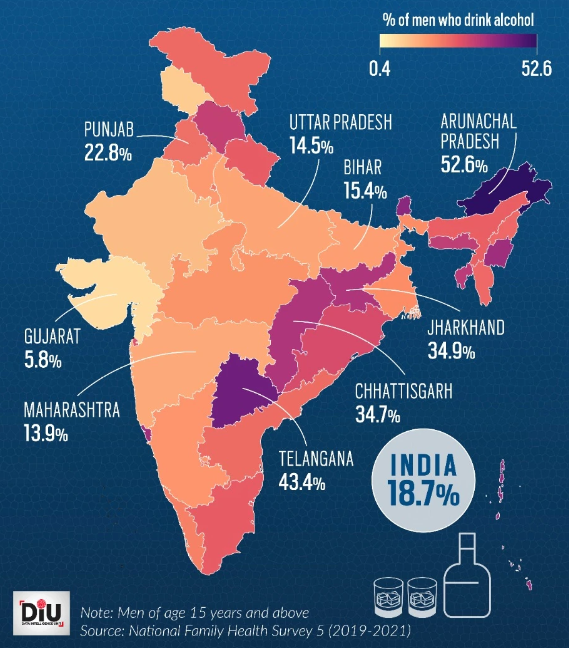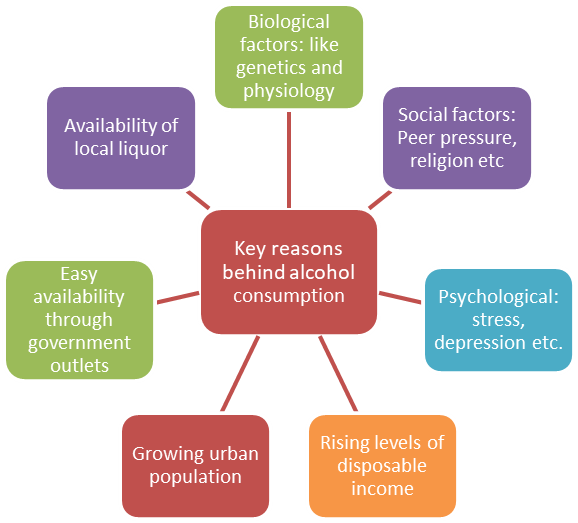Alcohol Prohibition in India
2022 DEC 27
Mains >
Society > Features of Indian Society > Women and Child issues
IN NEWS:
- In a hooch tragedy in Bihar, about 82 people have reportedly died from alcohol poisoning. According to critics, the state's prohibition policy is one of the causes of the tragedy.
ALCOHOL PROHIBITION IN INDIA:
- Prohibition of alcohol was a key part of the Mahatma Gandhi’s politics during the freedom struggle and he made prohibition a priority of the Indian National Congress.
- It was also made a part of the Indian Constitution by the Constituent Assembly.
- Article 47 under the Directive Principles talk about raising the level of nutrition and the standard of living in the country. The objective is to improve public health and the State shall endeavour to bring about the prohibition of intoxicating drinks and drugs which are injurious to health.
- As per the seventh schedule, Alcohol is a state subject. Hence, state legislatures have the right and obligation to create laws regarding it, including "the production, manufacture, possession, transport, purchase, and sale of intoxicating liquors”.
- As a result, there are differences in alcohol-related laws from state to state. Currently, total prohibition is in place in five states, and partial prohibition is in place in a few more. Some of these include:
- Gujarat: Gujarat has practised prohibition ever since it became a state in 1960. Over the years, the Act has undergone a number of amendments. Notably, the death penalty for sellers and producers of fake alcohol that results in fatalities was instituted in 2009.
- Bihar: The state completely outlawed the sale and possession of alcohol in 2016. Those found to have violated the ban were subject to harsh penalties, such as hefty fines and prison terms.
- Mizoram: Mizoram reverted to being a "dry state" in 2019 after the new government reinstated a prohibition that had been repealed in 2015. Mizoram had previously been under prohibition for 18 years.
- Lakshadweep: Keeping in mind the culture and sentiments of its predominantly Muslim population, the Union Territory prohibits both the consumption and sale of alcohol, except on the island of Bangram.
- Nagaland: Nagaland implemented total prohibition in 1989 for "moral and social" reasons, for the benefit of its citizens.
- Partial prohibition:
- Karnataka, which specifically prohibited country-made arrack in 2007
- Maharashtra, where the districts of Wardha and Gadhricholi have prohibited the production and sale of liquor.
- Manipur, where the sections of Bishnupur, Imphal East, Imphal West, and Thoubal have prohibition.
- Other states have enforced age restrictions and requirement of permits to regulate the consumption of liquor.


ARGUMENTS FAVOURING PROHIBITION:
- Realise the Gandhian ideal:
- Mahatma Gandhi was a champion of the temperance movement. Article 47 was included in the constitution in order to fulfil the dreams of Gandhi.
- Reduce crimes against women:
- Studies have found evidence linking alcohol to domestic abuse or violence. In Bihar, since prohibition was implemented in 2016, crimes against women have declined both in terms of rate (registered cases per 100,000 female population) and incidence (absolute numbers).
- Social upliftment:
- Consumption of alcohol is a bigger drain on the economically underprivileged than on others. Ban on alcohol can prevent the squandering of family income.
- Also, prohibition in India is a "women's rights" issue, since its consumption leads to lost incomes and domestic violence against them. Hence, prohibition can directly contribute to women empowerment efforts in the country.
- Better health outcomes:
- NFHS 5 data shows that 10 million Biharis have quit alcohol since the ban. This can contribute to lesser instances of diseases like alcohol induced liver cirrhosis.
- Also, a study by the Patna-based Asian Development Research Institute found that household spend on items like milk have gone up post the ban.
ARGUMENTS OPPOSING PROHIBITION:
- Loss of revenue for state:
- Alcohol for human consumption is outside the purview of GST and is a major contributor to own tax revenue of states. A ban can severely affect the states’ financial stability and social spending ability.
- For instance, between 2016 and 2021, Kerala has collected Rs 46,500 crores in liquor tax. Every day the state collected Rs 25 crore in liquor tax and Rs 766 crores each month.
- Fuels organised crime:
- Prohibition creates opportunities for bootlegging, organised crime mafias and the distribution of counterfeit liquor. This in turn causes a risk to public health as well as security.
- Disproportionate impact:
- On individuals: Prohibition disproportionately affects the poorer sections of society. For instance, in Bihar, majority of cases registered under the prohibition laws target the less fortunate.
- On States: Richer states like Gujarat can manage the fiscal impact of a ban because it can earn its revenues from other industries. But poorer states like Bihar have very few alternate financial sources.
- Right to Choice:
- A total ban on alcohol goes against an individual’s right to choose and undermines a person’s freedom.
- Impact on blue collar workers:
- Proponents argue that there are some in our society for whom alcohol is an essential good, like those who engage in hard physical labour. A total ban may affect their lives.
- Limitations of law:
- Even without a ban, alcohol consumption in both Uttar Pradesh (15%) and Maharashtra (14%) are similar to Bihar (15.4%). This shows that the prohibition act has hardly influenced the consumption culture in Bihar.
- Burden on judiciary:
- Prohibition creates excess burden on the already strained judicial system. For instance, about 4.5 lakh cases are pending under the under Bihar Prohibition and Excise Act, 2016.
WAY FORWARD:
Prohibitory laws alone cannot alter the demand of the alcohol market. So, the government should work towards influencing the demand side. To attain this, the following measures can be adopted:
- Increase awareness:
- Ensuring broad access to information and effective education and public awareness programmes regarding the harms of alcohol consumption.
- Eg: Developing high-intensity, well-executed mass media campaigns targeted at specific situations such as holiday seasons or audiences such as young people.
- Strengthen health services' response:
- Invest in health and social welfare systems to deliver prevention, treatment and care for alcohol-use and alcohol-induced disorders and co-morbid conditions.
- Community action:
- Mobilise communities to prevent the sale and consumption of alcohol by under-age drinkers and develop and support alcohol-free environments.
- Avoid stigmatization and actively discourage discrimination against affected groups and individuals.
- Countermeasures:
- Regulate the availability of alcohol through measures like alcohol permits, regulating days and hours of retail sales etc.
- Strengthen counselling, shelter homes and treatment programmes for alcohol users.
- Banning or restricting the use of surrogate advertisements for promoting alcohols.
- Stringent monitoring by law enforcement agencies to eliminate availability of illicit production.
PRACTICE QUESTION:
Q. Analyse the reasons behind the prevalence of alcohol consumption in Indian society. Do you think that prohibition of alcohol is an effective solution towards combating consumption?

